Trivago Bundle
How Does Trivago Revolutionize Hotel Searching?
In the ever-evolving world of online travel, Trivago has become a household name. But how does this global hotel search platform actually work, and what makes it so successful? By aggregating millions of hotel deals, Trivago SWOT Analysis provides a powerful tool for travelers seeking the best value.
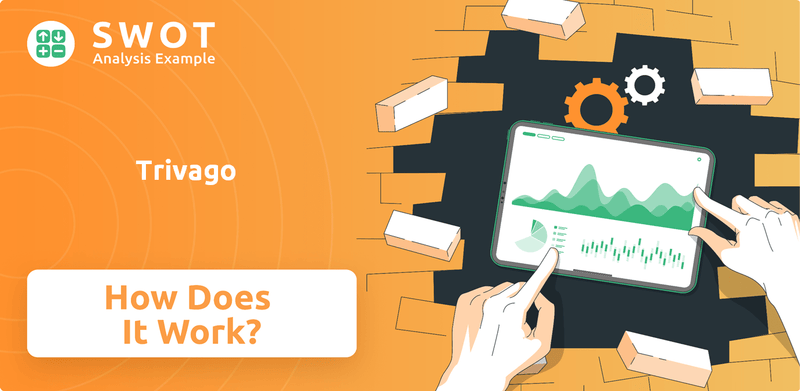
Trivago's innovative approach as a travel search engine allows users to effortlessly compare prices from various online travel agencies and hotels. This unique business model, focusing on hotel comparison, has positioned Trivago as a key player in the online travel agency landscape. Understanding the specifics of how Trivago operates, from its search algorithm to its revenue streams, is crucial for anyone interested in the future of digital travel.
What Are the Key Operations Driving Trivago’s Success?
The core operation of a company like Trivago revolves around its function as a meta-search engine. This means it aggregates hotel information from various sources, providing a platform for users to compare prices. The company doesn't directly sell hotel rooms, but instead, it connects users with Online Travel Agencies (OTAs) and hotel websites, streamlining the search process.
The value proposition of Trivago is centered on offering transparency and efficiency to travelers. It allows users to find the best deals without the hassle of visiting multiple booking sites individually. The primary customer segments include individual travelers seeking accommodation, ranging from budget-conscious to luxury seekers, across global destinations.
The operational process begins with Trivago's extensive network of partnerships with thousands of OTAs, hotel chains, and independent hotels. Through these partnerships, Trivago receives real-time pricing and availability data. Its proprietary algorithms then process this vast dataset, presenting users with a consolidated and easily comparable list of options based on their search criteria, such as destination, dates, and preferences.
The Trivago business model is built around its meta-search engine, which compares hotel prices from various sources. It doesn't handle bookings directly, acting as a bridge between users and OTAs. This approach allows Trivago to offer a wide range of options and maintain neutrality in its price comparisons.
Key features include a user-friendly interface, advanced search filters, and a mobile app for on-the-go access. The search algorithm is constantly updated to improve accuracy and speed. Trivago also provides detailed hotel information, including reviews and ratings, to help users make informed decisions.
Technology development is at the heart of Trivago's operations, focusing on enhancing its search algorithms, user interface, and mobile applications to ensure a seamless and intuitive experience. The company continuously refines its platform to improve search accuracy, speed, and personalization. This focus on technology is crucial for maintaining its competitive edge in the travel search engine market.
The core capability translates directly into customer benefits by saving them time and money, and it provides market differentiation by offering a truly unbiased comparison platform. This allows Trivago to maintain neutrality and focus solely on providing comprehensive price comparisons, thereby building trust with users.
The supply chain is fundamentally digital, relying on robust data feeds from its partners. Its distribution network is primarily online, with its website and mobile apps serving as the main channels for user engagement. This digital infrastructure allows Trivago to efficiently manage and update its vast database of hotel information.
- Partnerships with OTAs, hotel chains, and independent hotels provide real-time pricing and availability.
- Proprietary algorithms process the data to present users with a consolidated list of options.
- The platform is continuously refined to improve search accuracy, speed, and personalization.
- Focus on the meta-search model differentiates it from traditional OTAs.
The company's revenue model is primarily based on cost-per-click (CPC) advertising, where OTAs pay Trivago each time a user clicks on a hotel listing and is directed to their site. This model aligns with its goal of providing unbiased comparisons, as it doesn't favor any particular OTA. For more insights, you can read about the Growth Strategy of Trivago.
Trivago SWOT Analysis
- Complete SWOT Breakdown
- Fully Customizable
- Editable in Excel & Word
- Professional Formatting
- Investor-Ready Format
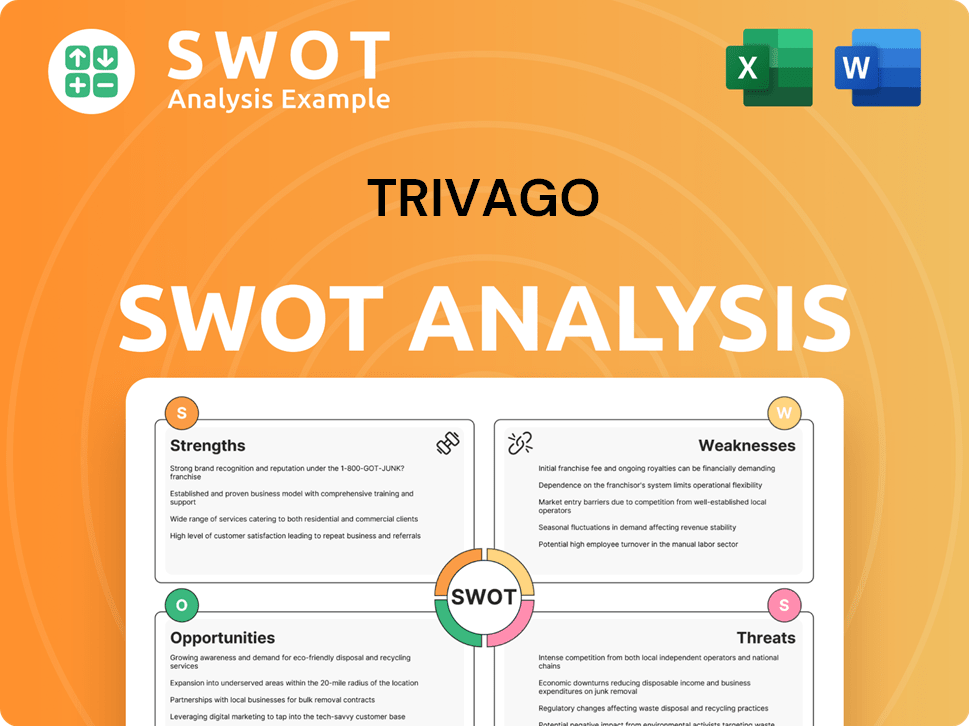
How Does Trivago Make Money?
Understanding the revenue streams and monetization strategies of Trivago is key to grasping its business model. Trivago primarily operates as a travel search engine, and its financial success hinges on how it converts user interactions into revenue.
The main method Trivago uses to generate income is the cost-per-click (CPC) model. This means that when a user clicks on a hotel deal and is redirected to an online travel agency (OTA) or a hotel's direct booking website, Trivago earns money. The more clicks, the more revenue.
In the first quarter of 2024, Trivago reported a total revenue of €98.5 million, showing its continued dependence on the CPC model. This demonstrates the effectiveness of its core monetization strategy.
While CPC is the main source of income, Trivago also explores other revenue streams. These include referral fees or commission-based agreements. These alternative methods contribute to a diversified revenue mix.
- Referral Fees: Trivago might receive a percentage of the booking value when a user makes a reservation after being redirected from its platform.
- Commission-Based Agreements: Partnerships with OTAs and hotels can involve commission structures, adding to the revenue.
- Mobile Optimization: Trivago focuses on optimizing its platform for mobile users.
- Emerging Markets: Expansion into new markets is a strategic move to boost revenue.
The revenue mix is influenced by market dynamics and travel trends. Peak travel seasons typically increase search volume and clicks, directly impacting revenue. For more details on the Marketing Strategy of Trivago, you can check out this article Marketing Strategy of Trivago.
Trivago PESTLE Analysis
- Covers All 6 PESTLE Categories
- No Research Needed – Save Hours of Work
- Built by Experts, Trusted by Consultants
- Instant Download, Ready to Use
- 100% Editable, Fully Customizable
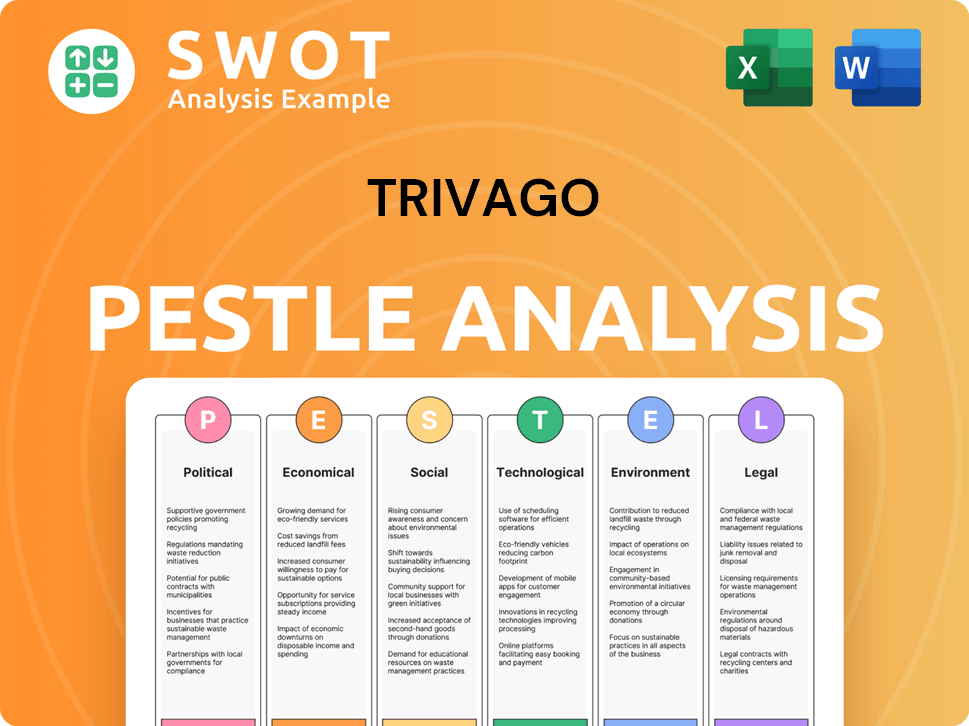
Which Strategic Decisions Have Shaped Trivago’s Business Model?
The journey of the company has been marked by significant milestones and strategic decisions. A pivotal moment was its acquisition by Expedia Group in 2012, which provided substantial resources and global reach. This partnership accelerated expansion into new markets and enhanced technological capabilities. Another key milestone was its initial public offering (IPO) in 2016, solidifying its position in the online travel industry.
Operational and market challenges have included intense competition and the volatility of the travel industry, especially during the COVID-19 pandemic. During the pandemic, the company faced significant revenue declines due to travel restrictions and reduced demand. The company responded by focusing on cost control and adapting its marketing strategies to cater to domestic and localized travel trends. This demonstrated its agility in navigating adverse market conditions.
The company's competitive advantages are rooted in strong brand recognition, technological leadership, and an extensive network effect. Its brand is widely recognized globally, making it a top-of-mind choice for hotel price comparison. Technologically, its sophisticated algorithms and user-friendly interface provide a superior search experience, aggregating vast amounts of data efficiently. The network effect is evident in its expanding partnerships with OTAs and hotels, which in turn attract more users, creating a virtuous cycle.
The acquisition by Expedia Group in 2012 significantly boosted its resources and global reach. The IPO in 2016 provided capital for further investment. These moves were crucial for its growth.
Focus on cost control and adapting marketing during the pandemic showed its agility. Investing in AI and machine learning for personalization is a key strategy. Monitoring consumer preferences, like sustainable travel, is also important.
Strong brand recognition makes it a top choice for hotel price comparison. Sophisticated algorithms and user-friendly interfaces offer a superior search experience. Extensive partnerships with OTAs and hotels create a strong network effect.
Intense competition from other meta-search engines and direct booking platforms is a constant. The volatility of the travel industry, particularly during global events, presents ongoing challenges. Adapting to changing consumer behaviors is essential.
The company continues to adapt to new trends by investing in artificial intelligence and machine learning to personalize user experiences and improve search relevance. It also monitors shifts in consumer preferences, such as the increasing demand for sustainable travel options, to ensure its platform remains relevant and competitive. Understanding the growth strategy of the company is key to its success.
- Focus on AI and machine learning for personalized experiences.
- Monitoring the increasing demand for sustainable travel options.
- Adapting to changing consumer behaviors.
- Maintaining a competitive edge in the online travel market.
Trivago Business Model Canvas
- Complete 9-Block Business Model Canvas
- Effortlessly Communicate Your Business Strategy
- Investor-Ready BMC Format
- 100% Editable and Customizable
- Clear and Structured Layout
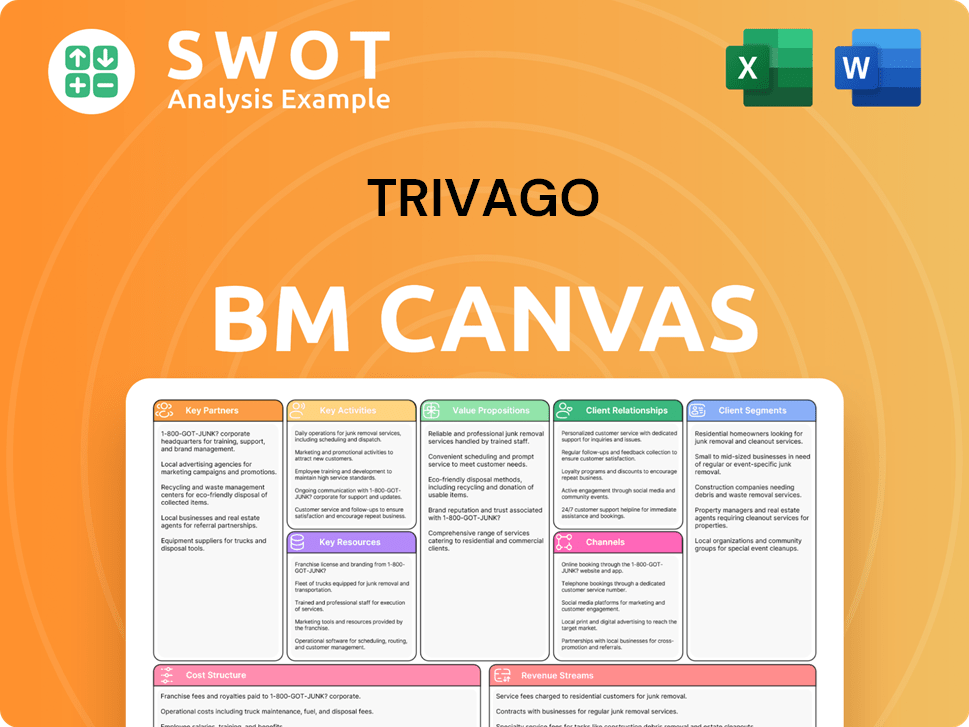
How Is Trivago Positioning Itself for Continued Success?
Trivago holds a prominent position in the online travel sector, particularly within the hotel meta-search market. Its role as a price comparison platform, rather than a direct booking site, sets it apart from major online travel agencies (OTAs). This unique positioning allows it to maintain a distinct market share, supported by strong brand recognition and a global reach that attracts a loyal customer base. Travelers often use the platform to find the best hotel deals, making it a key player in the travel search engine landscape.
However, Trivago faces several risks. Regulatory changes concerning data privacy and advertising practices could affect its operations and revenue. The emergence of new competitors, including tech giants, poses a continuous threat. Technological advancements, such as AI-powered travel planning, could shift consumer behavior. Changes in consumer preferences, like the demand for direct bookings, also present challenges if Trivago fails to adapt. Understanding the dynamic nature of the online travel agency market is crucial for evaluating Trivago's long-term prospects.
Trivago's position is strong due to its focus on hotel comparison, differentiating it from direct booking sites. The platform benefits from brand recognition and global reach, attracting a loyal customer base. Its ability to offer price comparisons helps it maintain a competitive edge in the online travel agency market.
Regulatory changes, particularly in data privacy and advertising, pose risks. New competitors and technological advancements, like AI travel planning, threaten its business model. Changing consumer preferences, such as a preference for direct bookings, also present challenges. These factors can impact the Brief History of Trivago and its future.
Trivago is focused on enhancing user experience through personalization and mobile optimization. It is also diversifying its advertising solutions beyond the cost-per-click model. The company aims to leverage data and technology to improve search results and provide value to users and advertising partners.
Trivago's primary revenue stream is through advertising, primarily from cost-per-click (CPC) revenue generated when users click on an offer. The company's revenue is highly dependent on the number of qualified referrals. In 2023, the company reported a revenue of approximately €470 million, with a significant portion coming from advertising revenue.
Trivago's strategic initiatives focus on enhancing user experience and diversifying advertising solutions. The company is investing in personalization and mobile optimization to improve its platform. It is also exploring new advertising formats beyond the traditional cost-per-click model to increase revenue streams.
- Enhancing User Experience: Personalization and mobile optimization.
- Diversifying Advertising Solutions: Exploring new ad formats.
- Leveraging Data and Technology: Improving search results.
- Expanding Global Presence: Maintaining its global reach.
Trivago Porter's Five Forces Analysis
- Covers All 5 Competitive Forces in Detail
- Structured for Consultants, Students, and Founders
- 100% Editable in Microsoft Word & Excel
- Instant Digital Download – Use Immediately
- Compatible with Mac & PC – Fully Unlocked
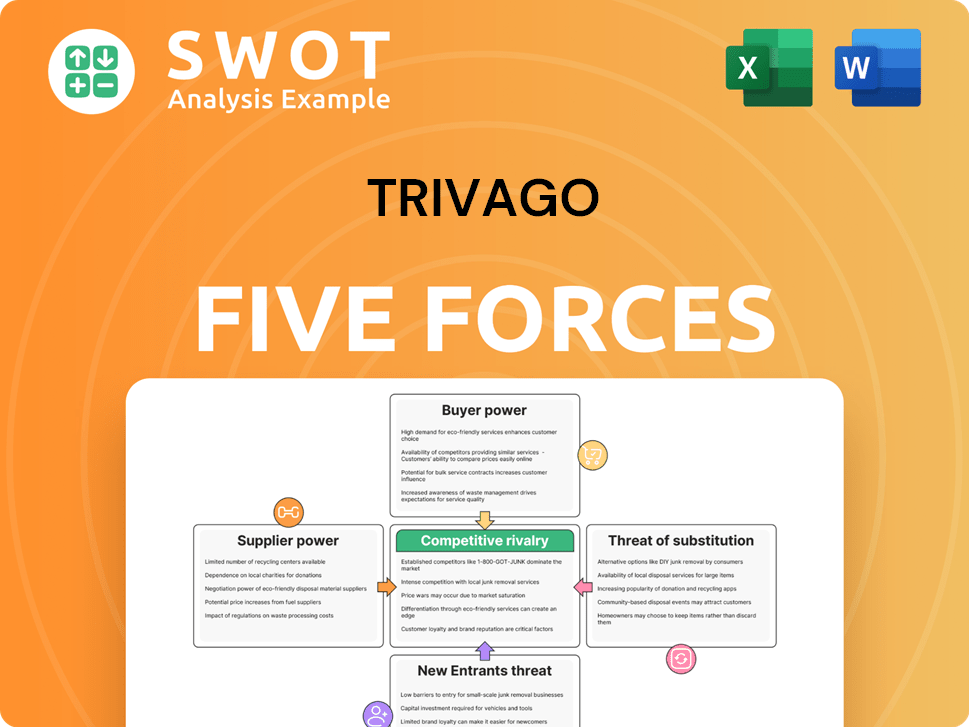
Related Blogs
- What are Mission Vision & Core Values of Trivago Company?
- What is Competitive Landscape of Trivago Company?
- What is Growth Strategy and Future Prospects of Trivago Company?
- What is Sales and Marketing Strategy of Trivago Company?
- What is Brief History of Trivago Company?
- Who Owns Trivago Company?
- What is Customer Demographics and Target Market of Trivago Company?
Disclaimer
All information, articles, and product details provided on this website are for general informational and educational purposes only. We do not claim any ownership over, nor do we intend to infringe upon, any trademarks, copyrights, logos, brand names, or other intellectual property mentioned or depicted on this site. Such intellectual property remains the property of its respective owners, and any references here are made solely for identification or informational purposes, without implying any affiliation, endorsement, or partnership.
We make no representations or warranties, express or implied, regarding the accuracy, completeness, or suitability of any content or products presented. Nothing on this website should be construed as legal, tax, investment, financial, medical, or other professional advice. In addition, no part of this site—including articles or product references—constitutes a solicitation, recommendation, endorsement, advertisement, or offer to buy or sell any securities, franchises, or other financial instruments, particularly in jurisdictions where such activity would be unlawful.
All content is of a general nature and may not address the specific circumstances of any individual or entity. It is not a substitute for professional advice or services. Any actions you take based on the information provided here are strictly at your own risk. You accept full responsibility for any decisions or outcomes arising from your use of this website and agree to release us from any liability in connection with your use of, or reliance upon, the content or products found herein.